
Evolution of "F - 16" From "Kofana"...
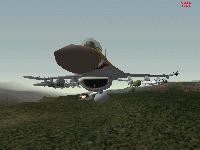
Evolution Chapter - 01...
All F-16s are not created equal. The Fighting Falcons rolling out of the factory
today are not the Fighting Falcons that rolled out of the factory twenty years
ago. Some differences are visible-larger horizontal tails, a wider inlet, a larger
head-up display, square landing lights, tinted canopies, a thicker root and cap on
the vertical tail, and various antennas, vents, bumps, and blisters. Most differences
require more than a naked eye to see-digital electronics, vastly increased computing
capacity, structural beef-ups, improved engines, and all the software changes to
accommodate new functions, sensors, and weapons. The original F-16 was designed as
a lightweight air-to-air day fighter. Air-to-ground responsibilities transformed
the first production F-16s into multirole fighters. F-16s that followed expanded
and refined these multiple roles with beyond-visual-range missiles, digital flight
controls, infrared sensors, precision-guided munitions, high-speed antiradiation
missiles, and a variety of other capabilities. Advanced versions of the F-16 just
around the corner build upon these refinements to enhance capability further.
This evolution, however, has not devitalized the fundamental strengths of the
original design. At the heart of every Fighting Falcon coming off the line is the
lightweight fighter concept championed by John Boyd, Tom Christie, John Chuprun,
Harry Hillaker, Chuck Meyers, Pierre Sprey, Everest Riccioni, and other members of
what came to be known as the Fighter Mafia. This group favored simple and small
fighter designs. Such aircraft can change direction and speed faster than their
potential adversaries. Smaller aircraft are harder to detect visually and
electronically. The Fighter Mafia advocated designs that are inexpensive to
produce, operate, and maintain. They used technology not for the sake of using
technology, but to increase effectiveness or to reduce cost. They went so far as
to question and thoroughly analyze the basic assumptions that underlie how fighters
are judged and compared.
General Dynamics Fort Worth transformed these ideas into reality in the 1970s. The
resulting lightweight fighter set new performance standards for fighter aircraft.
The basic design combined a host of advanced technologies that had never been used
in previous operational fighters. A blended wing-body, variable camber wings, and
forebody strakes provided extra lift and control. Fly-by-wire flight controls
improved the response time and replaced heavy hydromechanical systems with lighter
and smaller electronic systems. Relaxed static stability, made possible by the
fly-by-wire system, greatly enhanced agility. Side-mounted throttle and stick,
head-up display, thirty-degree seat back angle, hands-on controls, and a bubble
canopy improved g-tolerance and situational awareness for the pilot. All of these
technologies had been explored in a variety of other aircraft and research programs.
But the F-16 prototype, or YF-16, was the first airplane to incorporate them all
into one package.
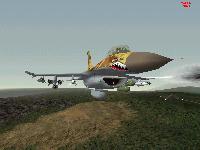
Evolution Chapter - 02...
The development of the YF-16 maximized a design for performance. The evolution of
the F-16, on the other hand, has been a balance between adding improved capabilities
and maintaining the performance levels of the original design.
Capability improvements have often come in the form of weapons, pods, and fuel tanks
tucked under the wings, attached to the centerline, and affixed to the intake. The
airframe itself has been beefed up to handle some of these additions. The good news
is that these increases in capability are packed into an airframe still capable of
sustaining nine g's. The bad news is that additional weight and drag have accompanied
these new capabilities.
The F-16 may have started life as a lightweight fighter, but it hasn't been completely
immune to the "pound a day" appetite that applies to all fighters. The empty weight
of the Block 10 F-16A is 15,600 pounds. The empty weight of the Block 50 is 19,200
pounds. The increase equates to less than half a pound a day, but it is additional
weight nonetheless. (The empty weight of the YF-16 with two AIM-9 missiles was
14,023 pounds. The prototypes, however, did not have a fire control radar and
avionics characteristic of an operational airplane.)
Fortunately Pratt & Whitney and General Electric have stepped up to the scale and
offset much of the weight and drag gains with some impressive improvements in
engine performance. The original Pratt & Whitney engine on the YF-16 developed
over 23,000 pounds of thrust. The engines on the Block 50/52 aircraft develop
nearly 30,000 pounds of thrust. The next round of engine improvements is expected
to boost this figure to as high as 37,000 pounds. So, even though weight has
increased, the thrust-to-weight ratio of the F-16 has actually improved over time.
But any Fighter Mafia member will point out that thrust-to-weight ratio is not the
only indicator of aircraft performance. The figure doesn't account for the effects
of wing loading and aerodynamic drag. A better measure of performance is energy
rate (or Ps), which is a function of thrust, weight, velocity, and drag. Every
external payload extracts a performance price in aerodynamic drag. And F-16s rarely
fly without a few items under the wing.
But technology has come to the rescue again. Advances in electronic miniaturization
have significantly reduced aerodynamic drag as well as resulted in lighter and more
compact hardware. The latest navigation and targeting pods, for example, are smaller,
lighter, and aerodynamically cleaner than the first-generation pods. Further advances
have placed infrared targeting and navigation sensors inside the airframe. Electronic
countermeasure systems have shrunk through the years and have more recently found
their way under the F-16's skin, eliminating even more aerodynamic drag. Weaponeers
are hard at work making bombs and missiles smaller, lighter, and more streamlined.
Most of these changes, however, have not been made with aerodynamic intentions.
Drag reductions have often accompanied efforts to put more systems and weapons on
the airplane and to make the airplane stealthier.
While the F-16 has benefited from the electronic revolution, the original designers
did not anticipate the revolution. In fact, they kept the aircraft as dense as
possible to prevent additional systems-and the extra weight they would bring-from
being placed inside the airframe. Technology advances have allowed much more capability
to be packed into that same space.
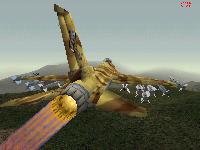
Evolution Chapter - 03...
Keeping up with all the varieties of the F-16 through the years is no small task.
The fact that most changes were made in groups, or blocks, to track things on the
production line simplifies the job. Block is an important term in tracing the F-16's
evolution. Basically, a block is a numerical milestone. The block number increases
whenever a new production configuration for the F-16 is established. The first
production aircraft that followed the two YF prototypes and the eight full-scale
development F-16s, for example, were Blocks 1 and 5. Today, the latest F-16s are
designated Block 50/52. Block 50 has a General Electric engine. Block 52 has a
Pratt and Whitney engine. (From Block 30/32 on, a major block designation ending
in 0 signifies a General Electric engine; one ending in 2 signifies a Pratt &
Whitney engine.) Block 55 and Block 60 are often used to describe concepts for
advanced versions of the F-16, but the terms do not indicate engine selection.
F-16 neophytes note: The A in F-16A refers to a Block 1 through 20 single-seat
aircraft. The B in F-16B refers to the two-seat version. The letters C and D were
substituted for A and B, respectively, beginning with Block 25. The new letters
emphasize the significance of the change that occurred between Block 15 and 25.
Not all F-16s within a given block are the same. They fall into a number of block
subsets called miniblocks. These sub-block sets are denoted by capital letters
following the block number (Block 15S, for example). Miniblock designations
originate for production purposes. However, some of these miniblock capabilities
are retrofitted after the airplane leaves the factory. The designation represents
a list of changes associated with a particular F-16 block at a certain point in
that block's production. All Block 15S aircraft will have the same capabilities
and the same technical orders. The latest F-16s are now up to a Block 50H miniblock
designation.
The formal process behind these changes is relatively straightforward. Every change
that occurs on the F-16 has an engineering change proposal, or ECP, attached to it.
The ECP process, which is not unique to the F-16, begins with a form, an advanced
change study notice from the Air Force officially requesting a change on the F-16.
The vast majority of these requests are for improving capability. The request generates
a Lockheed Martin proposal that includes detailed engineering descriptions, development
tasks, support impact, costs, and schedules. An ECP number is attached when the proposal
is accepted. The ECP process, from the time the study notice is submitted to the actual
hardware rolling off the line, takes from a couple of months to two years, depending
on the size and nature of the change. ECPs, in turn, affect flight manuals and technical
orders for maintaining the F-16.
An ECP can apply to changes ranging from a single wire to an entire structural
upgrade involving thousands of parts and complex procedures. The transition of the
F-16 from Block 10 to Block 15, for example, is covered by one ECP (ECP 350 to be
exact). To date, over 2,200 ECPs have been written for the F-16.
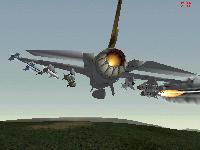
Evolution Chapter - 04...
The F-16's evolution predates the ECP process for the airplane. The first major
transition from one version of the airplane to another occurred right after the
two F-16 prototypes won the lightweight fighter competition and work began on the
first of eight full-scale development, or FSD, F-16s. The differences between the
prototype and the F-16s that followed are mostly internal. Those who transformed
the prototype into an operational fighter wanted to retain the outstanding flying
qualities of the original. So, they were careful to make no changes that would
degrade its aerodynamics. At the same time, they had to adapt the airplane to
amplified air-to-ground requirements that foreshadowed the F-16's transition into
a multirole fighter. The changes in shape were, therefore, kept to a minimum. The
overall length grew by thirteen inches. The nose, which accounts for about three
of those inches, acquired a slight droop to accommodate the Westinghouse APG-66
radar.
The increased emphasis on air-to-ground capability implied larger payloads. The
wing and tail expanded accordingly to carry the extra loads. The wing area grew
from 280 to 300 square feet, which is about as much as it could grow without
requiring additional bulkheads to lengthen the fuselage. The horizontal tails and
ventral fins grew in area by about fifteen percent. The flaperons and speed brakes
grew by about ten percent. An additional hardpoint was placed under each wing,
giving the aircraft a total of nine. The airframe was structurally strengthened
for these new loads as well.
Many other changes brought the FSD aircraft closer to being fully operational. A
lighter weight Stencel SIIIS ejection seat replaced the ESCAPAC seats used in the
prototypes. A simpler single door was substituted for twin doors on the front landing
gear bay. A self-contained jet fuel engine starter was added. The canopy transparency
was strengthened to withstand a four-pound, 350-knot bird strike. The radome was
hinged to permit easier access to the radar.
Some interesting items were used on the prototypes to keep development costs low.
These items included main landing gear tires from the B-58 Hustler, an emergency
power unit from the Concorde, an ejection seat from the A-4, a forked air data
probe from the SR-71 Blackbird, and servo actuators from the F-111 Aardvark. The
actuators in the leading edge flaps were rotary actuators from the F-111 bomb bay
doors. The canopy design and the canopy latching system was based on the X-24.
A lot of off-the-shelf equipment, however, did make it onto the FSD aircraft,
including a head-up display modified from an A-7 Corsair, nosegear wheel and tire
from the F-4, a signal data recorder from the A-10, an oxygen quantity indicator
from an F-5E, and a nosewheel steering system from the T-39. The engine, of course,
was a modified version of the Pratt & Whitney F100 engine used in the F-15.
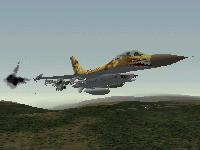
Evolution Chapter - 05...
Besides winning the lightweight fighter competition, the YF-16 also successfully
validated the aerodynamics, propulsion, and handling qualities of the basic design
of the airplane. With these major design issues out of the way, engineers could
concentrate more on internal details-such as the electrical system, hydraulics,
and avionics-with the FSD aircraft. The high readiness and flight rates of the
first production F-16s are attributable to the level of maturity achieved with the
prototype design.
The FSD aircraft had no block numbers, though they are often referred to as Block
0 F-16s. These earliest F-16s are recognizable in photos by their black radomes and
lack of threat warning receiver fairing protruding aft and just below the rudder in
production F-16s. The aircraft can also be distinguished by their tail numbers,
which range from 0745 through 0752.
The first FSD F-16, which was delivered in December 1976, was used for flutter,
propulsion, performance, and flying qualities testing. It was also the first F-16
to fly with the General Electric F101 derivative fighter engine, the forerunner of
the F110 introduced at Block 30 (the F101 powers the B-1B). F-16A No. 1, as it is
called, is now on display at Wright-Patterson AFB in Ohio. The second FSD aircraft
was used for structure and performance tests. It is now being used as a static test
article near Fort Worth. The third FSD F-16, which flew for the first time in 1977,
was the first F-16 to have a full suite of avionics. It was used for avionics, fire
control system, vibration, acoustics, and electromagnetic testing. This aircraft
was later converted from a single-seat F-16 to the two-seat F-16XL No. 2. It is
now a research aircraft for NASA and flown from Dryden Research Center at Edwards
AFB in California.
The fourth FSD F-16 was used for flying qualities, performance, avionics, and
weapon separation tests. It is now on display at the USAF Academy. The fifth FSD
was used for flying qualities and weapon separation tests. It was later converted
into the single-seat F-16XL No. 1, which is also currently being flown by NASA at
Dryden. The sixth FSD F-16 was used in climactic tests. It was later converted into
the AFTI/F-16, which has pioneered many fighter technologies and which will soon
be used to test all-electric actuator technologies for the Joint Strike Fighter
program (see the Events section in this issue for more information).
The seventh FSD F-16, the first two-seater FSD aircraft, was used for maintenance
training and reliability testing. It was also the first F-16 to be modified with
the larger tail surfaces associated with the transition to Block 15 aircraft. This
aircraft is now on display at Edwards. The eighth FSD F-16, also a two-seater, was
also used for maintenance training and reliability testing. It was modified in 1980
to accept the General Electric J79-GE-119 engine, a derivative of the engine that
powers the F-4 Phantom and several other military aircraft. The engine mod was
later removed and the airplane was used extensively, until very recently, by
company test pilots to develop technologies for close air support, night vision,
off-boresight weapons, color displays, and a variety of other capabilities. It is
now in flyable storage in Fort Worth.
All of the FSD F-16s were used extensively in tests that went well beyond the
scope of the original FSD program. Even the two prototypes flew for many years
as platforms for a number of development programs that improved the capability
of the operational fleet. Today, these testing duties are performed primarily by
more advanced versions of the F-16.
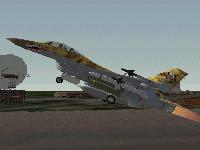
Evolution Chapter - 06...
After the prototype and full-scale development programs, the first Block 1 F-16
flew for the first time in August 1978 and was delivered to the Air Force that
same month. From there, it succeeded to a number of wings and groups before finding
a resting place. This first operational F-16 was first assigned to the 388th Tactical
Fighter Wing at Hill AFB, Utah. It later became an interceptor fighter with the 125th
Fighter Interceptor Group in Jacksonville, Florida. After that assignment, the aircraft
joined the 158th Fighter Interceptor Group in Burlington, Vermont. It then flew with
the 127th Tactical Fighter Wing at Selfridge Air National Guard Base in Michigan and
was eventually sent to Lowry AFB in Colorado as a student trainer. The F-16 is now
on display at Langley AFB in Virginia.
Ninety-four Block 1 and 197 Block 5 F-16s were manufactured through 1981 for USAF
and for four European air forces. Most Blocks 1 and 5 aircraft were upgraded to a
Block 10 standard in a program called Pacer Loft in 1982. New production Block 10
aircraft (312 total) were built through 1980. The differences between these early
F-16 versions are relatively minor, involving improvements to make the airplane
more reliable and more easily maintained. Both FSD and Block 1 F-16s are distinguishable
in photos by their black radomes. All operational aircraft eventually were retrofitted
with lower visibility gray noses. Production F-16s have ACES II ejection seats, the
USAF standard for all of its fighters. Blocks 1, 5, and 10 can be distinguished from
later F-16A models by a single UHF communications blade antenna below the inlet and
by smaller horizontal tails. Several air forces, however, have retrofitted larger
tails onto their early model F-16s.
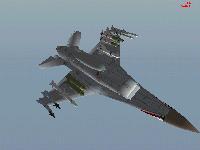
Evolution Chapter - 07...
The 330th production F-16 was the first of 983 Block 15 aircraft built in five
countries and on three production lines. The production of the Block 15 spanned
fourteen years. Of the more than 3,600 F-16s manufactured to date, Block 15 aircraft
represent the most numerous version.
The transition from Block 10 to Block 15 resulted in two hardpoints added to the
chin of the inlet that were designated stations 5R and 5L. The larger horizontal
tails are the most noticeable difference between Block 15 and previous F-16 versions.
The tails grew in area by about thirty percent. These larger control surfaces offset
the shift in center of gravity brought on by the weight of two additional hardpoints
on the inlet chin and their associated sensor pods and structure. The larger tails
also provide better stability and control authority, especially at higher angles
of attack.
Block 15 saw some structural improvements. It had internal provisions for the AIM-7
Sparrow air-to-air missile as well. The last production Block 15 rolled out of the
factory in 1996 and was delivered to Thailand. Eleven other countries fly Block 15
aircraft.
Block 15 aircraft received an operational capability upgrade, or OCU. This upgrade
added a data transfer unit and a radar altimeter. It also improved the radar, expanded
the fire control and stores control computers, allowed Block 15 aircraft to fire the
AGM-119 Penguin antishipping missile, the AGM-65 Maverick air-to-ground missile, and
the AIM-120 advanced medium-range air-to-air missile, or AMRAAM. The first F-16 to
have these upgrades installed on the production line was delivered in January 1988.
Block 15 aircraft built from 1988 on had OCU, larger head-up displays, and the Pratt
& Whitney F100-PW-220 engine. Most Block 15 aircraft produced before 1988 also
received OCU in a retrofit program that began that year.
The Air Defense F-16 is a variant of the Block 15 OCU F-16 equipped with some
additional systems for the air-to-air role. It has an improved APG-66A radar,
an APX-109 identification friend or foe interrogator, ARC-200 high-frequency
radio, standard flight data recorder, and a 150,000-candlepower spotlight mounted
on the left side of the forward fuselage. The Air Defense F-16 can fire the AIM-7
Sparrow air-to-air radar-guided missile using continuous wave illumination from
the radar. Like later F-16 versions, the air defense version can fire the AIM-120
AMRAAM radar-guided missile. The airplane is distinguishable by its four-bladed
"bird-slicer" antennas just forward of the canopy and under the engine inlet and
by the blistered tail root. The blisters were required to make room for the
high-frequency radio equipment.
Two-hundred and seventy Block 15 airframes were converted to the air defense
configuration in the late 1980s and early 1990s. All of the aircraft went to the
Air National Guard. The first air defense variant was delivered in early 1989. An
Air Defense F-16 unit from Fargo, North Dakota, proved the airplane's prowess when
it won the William Tell air-to-air competition in 1994. Five ANG units still
operate the Air Defense F-16. The Royal Jordanian Air Force is scheduled to
receive Air Defense F-16s later this year.
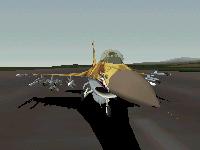
Evolution Chapter - 08...
The transition of the F-16 from Block 15 to Block 25 marks the evolution from the
F-16A/B to the F-16C/D models. Block 25 added in production the ability to carry
AMRAAM to the F-16 as well as night/precision ground-attack capabilities. An
improved fire control computer, an improved stores management computer, and a
USAF-standard inertial navigation system was added as well as multifunction
displays, data transfer unit, radar altimeter, anti-jam UHF radio, and provisions
for future electronic warfare systems.
The Block 25 F-16 also received an improved radar, the Westinghouse (now
Northrop-Grumman) AN/APG-68, with increased range, better resolution, and more
operating modes. Block 25 got a larger head-up display, two head-down multifunction
displays, and new up-front controls. All Block 25s were originally powered by the
Pratt & Whitney F100-PW-200, but they have since been upgraded to the -220E
configuration.
The first of 244 Block 25 F-16s flew in June 1984 and was delivered to the Air
Force in July. Block 25 is the only F-16 to be employed exclusively by USAF. An
F-16 Block 25 aircraft is distinguishable by its larger tail root with a small
blade antenna on the leading surface. The extra space in the tail root was intended
for an airborne self-protection jamming system. The space is being used for electronic
countermeasure systems by some subsequent F-16 blocks.
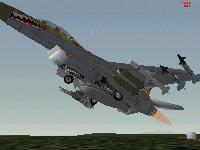
Evolution Chapter - 09...
Block 30/32 added two new engines-the Pratt & Whitney F100-PW-220 and the General
Electric F110-GE-100-to the F-16 line. Block 30 designates a GE engine, and Block
32 designates a Pratt & Whitney engine. A larger inlet was introduced at Block 30D
for the GE-powered F-16s, which are often called "big-mouth" F-16s. The larger inlet,
formally called the modular common inlet duct, allows the GE engine to produce its
full thrust potential at lower airspeeds.
The smaller inlet is called a normal shock inlet and has not changed for the -220
and subsequent Pratt & Whitney engines. A Pratt & Whitney F100-PW-229 engine now
powers the VISTA/F-16, which has the larger inlet. This is the only F-16 with a
large inlet and a Pratt & Whitney engine. The engine bays are common to both
engines.
Block 30/32 can carry the AGM45 Shrike and the AGM-88A high-speed antiradiation
missiles or HARM. Like the Block 25, it can carry the AGM-65 Maverick air-to-ground
missile. Changes at Block 30D allowed the aircraft to carry twice as many chaff/flare
dispensers. The aircraft has provisions for the ALR-56M advanced radar warning
receiver. Forward radar warning receiver antennas were relocated to the leading
edge flap at Block 30D. These "beer can" antennas have since been retrofit onto
all previous F-16C/D aircraft. Block 30/32 has a crash-survivable flight data
recorder, voice message unit, and expanded memory for the multifunction displays.
The first of 733 Block 30/32 F-16s was delivered in July 1987; the airplane was
manufactured through 1989.
The F-16N manufactured for the US Navy is a variation of the Block 30. It is
powered by the GE F110-GE-100 engine and has the small inlet associated with
early Block 30 production. The F-16N also has the APG-66 radar of the F-16A
models and minor structural differences for meeting Navy requirements. The
aircraft has no cannon. Twenty-two F-16Ns and four TF-16Ns (two-seaters) were
built from 1987 to 1988. They were used for dissimilar air-to-air training at
three Navy adversary squadrons and at the Navy's Fighter Weapons School (Top Gun).
The F-16Ns were retired from Naval service in 1994 for budget reasons.
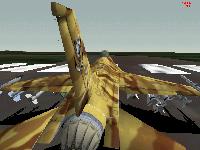
Evolution Chapter - 10...
With the Block 40/42, the F-16 gained capabilities for navigation and precision
attack in all weather conditions and at night. The F-16 traded its analog flight
controls for a digital system and new core avionics.
The landing gear of the Block 40/42 was beefed up and extended to handle the
LANTIRN pods and more extensive air-to-ground loads. The landing gear bay doors
bulge slightly by design to handle the larger wheels and tires. The LANTIRN pods
also forced the landing lights to move forward from the struts of the main landing
gear to the leading inside edge of the nose landing gear door. A larger head-up
display accompanied the LANTIRN system as well.
The precision weapons incorporated by the Block 40/42 include the GBU-10, GBU-12,
GBU-24 Paveway family of laser-guided bombs as well as the GBU-15 glide bomb.
Block 40/42 also saw the addition of the APG-68(V) radar, automatic terrain
following (part of the LANTIRN system), global positioning system, a new
positive-pressure breathing system to improve g tolerance for the pilot, full
provisions for internal electronic countermeasures, an enhanced envelope gun
sight, and a capability for bombing moving ground targets. Some foreign versions
of the aircraft can carry the AIM-7 Sparrow missile.
Block 40/42 production began in 1988 and ran through 1995. Twenty-one more Block
40s will be built for Egypt from 1999 to 2000. Bahrain is considering more Block
40s to equip a second squadron. The 744 Block 40/42 aircraft produced to date can
be distinguished externally from previous F-16 blocks by their landing lights and
by the bulged landing gear doors. Any USAF F-16 carrying a LANTIRN pod is a Block
40/42.
Some USAF Block 40 aircraft are now equipped and flying missions with night vision
goggles and with a data link system called Sure Strike. This system receives highly
accurate position information from a forward air controller on the ground. The system
then inputs the data into the weapon system computer and displays it as a waypoint
on the head-up display. Sure Strike was integrated into the F-16 in about two months
with off-the-shelf equipment. The data link is also used on the Apache helicopter.
An upgrade program to Sure Strike, called Gold Strike, is adding two-way imagery
transmission. This system will be operationally tested this year. The data link
capability will become standard equipment on new F-16s.
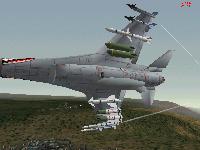
Evolution Chapter - 11...
Block 20 refers to new-production F-16As that incorporate significant avionic
enhancements, including a modular mission computer that replaces three other
computers, takes up almost half the space of the hardware it replaces, weighs
over fifty-percent less, has faster processing and large growth capacity, and
uses almost forty percent less power. The processing speed of the computer is
over 740 times faster than the computer in the original F-16. It has over 180
times the memory. An improved version of the APG-66 radar in the Block 20, the
APG-66(V2), has many new features, including increased detection and tracking
ranges and the ability to track more targets.
These F-16s also have an improved data modem, a ring laser inertial navigation
system, a miniaturized global positioning system, a digital terrain system, an
advanced interrogator for identifying friendly aircraft, wide-angle head-up
display, color multifunction cockpit displays, up-front controls (a set of
programmable pushbuttons placed just below the head-up display), and Block
50-style sidestick and throttle controllers. Cockpit lighting is compatible with
night-vision systems. MLU will also have provisions for microwave landing systems
and helmet-mounted displays.
These features are also being added to over 300 F-16A/B aircraft in the Mid-Life
Update program for Belgium, Denmark, the Netherlands, and Norway. These aircraft
are also being structurally upgraded so they can meet an 8,000-hour airframe
lifespan in a program called Falcon UP (for unos programmum). In addition to these
European countries, several other current and potential F-16 customers are considering
the upgrade as well. USAF is also planning to incorporate some of these systems, such
as the modular mission computer and color multifunction displays into new-production
Block 50/52 aircraft. USAF has plans to retrofit Block 40 and Block 50/52 with these
systems as well.
With its color displays, modular mission computer, and other features, the Block
20 represents one of the most advanced versions of the F-16 being produced today.
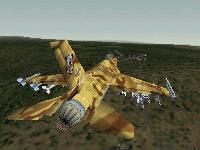
Evolution Chapter - 12...
The latest version of the F-16C/D is the Block 50/52. The Block 50/52 F-16 is best
recognized for its ability to carry the AGM-88 HARM in the suppression of enemy air
defenses, or SEAD, mission. The AGM-88 is a second-generation air-to-ground antiradiation
missile. The F-16 can currently carry two HARMs, though four-HARM loads are being
flight-tested at Eglin AFB.
A HARM avionics launcher interface computer allows the F-16 to launch the HARM
missile. The F-16 has quietly and competently taken over the Wild Weasel SEAD role
formerly conducted by the F-4G. The HARM is usually combined with a targeting pod
mounted on the right intake hardpoint. The pod contains a super-sensitive receiver
that detects, classifies, and ranges threats and passes the information to the HARM
and to the cockpit displays. With the targeting system, the F-16 has full autonomous
HARM capability. F-16s have, however, conducted joint exercises with RC-135 Rivet
Joint aircraft, which can help sort and prioritize targets in dense threat environments.
The Block 50/52 is the first F-16 version to integrate the AGM-84 Harpoon
antishipping missile. The aircraft can launch the Harpoon in line-of-sight,
bearing-only, and range/bearing modes. The addition of the Harpoon gives the
F-16 a significant standoff range antishipping capability. When the Harpoon is
combined with optional 600-gallon fuel tanks, the Block 50/52 has an unmatched
maritime patrol and attack capability.
The Block 50/52 F-16 is equipped with the APG-68(V5) radar, which offers longer
range detection against air targets and higher reliability. The radar has a programmable
signal processor that employs very high-speed integrated circuit technology. The F-16
is the first US military aircraft to employ this VHSIC technology.
The Block 50/52 also includes a ring laser gyro inertial navigation system, a
global positioning system receiver, a larger capacity data transfer cartridge,
an improved data modem, the ALR-56M advanced radar warning receiver, the ALE-47
threat adaptive countermeasure system, a digital terrain system data transfer
cartridge, a cockpit compatible with night vision systems, and an advanced
interrogator for identifying friendly aircraft. An upgraded programmable display
generator has four times the memory and seven times the processor speed of the
system it replaces. New VHF/FM antennas increase reception ranges. The Block 50/52
is powered by increased performance engines-the General Electric F110-GE-129 and
the Pratt & Whitney F100-PW-229-each rated to deliver over 29,000 pounds of thrust
in afterburner.
New production Block 50/52 aircraft ordered after 1996 will also include color
multifunction displays, a three-channel video tape recorder, and the modular
mission computer. The throughput of the new computer dramatically increases the
processing power of the F-16 and will allow the airplane to continue to grow
indefinitely. All four international versions of the Block 50/52 will have LANTIRN
capability.
The first Block 50/52 was delivered to USAF in 1991. Over 300 have been delivered
so far from three production lines in Fort Worth, Korea, and Turkey. All three
production lines are producing Block 50/52s today. These F-16s have no features
that easily distinguish them from Block 40/42 aircraft. An HTS pod under the inlet
or a HARM attached to the wing, however, indicates a USAF Block 50/52. Block 52
aircraft are distinguishable by the black exhaust leaves of the Pratt & Whitney
Increased Performance Engine. The Block 50/52 is the newest and most advanced
fighter in the USAF fleet.
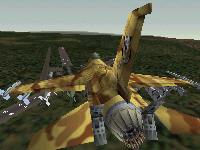
Evolution Chapter - 13...
The engines that power the F-16 have improved in more ways than maximum thrust.
Engines used in early F-16s took from six to eight seconds to spool up from idle
to afterburner. Since then, electronic controls have replaced hydromechanical
systems. The changes allow current engines to go from idle to full afterburner in
as few as two seconds. This responsiveness has a huge payoff in performance and
aircraft handling. Engine reliability and ease of maintenance have also been
improved significantly. Today's F-16 engines can be expected to deliver eight to
ten years of operational service between depot inspections.
Digital engine controls, first introduced on Pratt & Whitney powered F-16s in 1986,
have also improved performance. Older hydromechanical controls had to be trimmed to
operate at the most challenging point within the F-16's flight envelope. Digital
engine controls automatically adjust to the operating environment, so that they
optimize engine performance at all points within the flight envelope. This optimization
has increased thrust by more than ten percent in some areas of the F-16 flight envelope.
All engines being built today for the F-16 have second-generation digital engine controls.
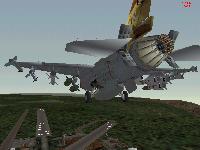
Evolution Chapter - 14...
With all the varieties of the F-16 produced through the years, it comes as no
surprise that USAF is trying to standardize its F-16 fleet to simplify logistics,
maintenance, and training. The service will soon be flying only Block 40/42 and
Block 50/52 F-16s in its active-duty units. Block 25 and Block 30/32 will be
concentrated in Air National Guard and Air Force Reserve units with a few
exceptions for those already flying more advanced versions of the F-16.
Two relatively new programs will further increase the combat capability of the
F-16, reduce operation and support costs, and help standardize the Air Force fleet.
The first will retrofit all Block 50/52 aircraft with two four-inch color cockpit
displays and the modular mission computer, developed for the Mid-Life Update
Program.
The second program, called the Common Configuration Implementation Program, adds
the color displays, common missile warning systems, and the modular mission computer
to Block 40/42 F-16s as well as an advanced data link to both Block 40/42 and Block
50/52 aircraft. The datalink, called Link 16, will be the standard for US and NATO
aircraft. A helmet-mounted cueing system is also being considered for this upgrade.
This system will work with the high-off-boresight AIM-9X air-to-air missile as well
as with other slewable sensors. Over 200 Block 50/52 and 450 Block 40/42 aircraft
are involved in the two programs. F-16s from both Guard and active units are scheduled
to be modified with the first of the upgraded aircraft operational in the year 2004.
F-16s will soon be the first aircraft to field a new family of smart weapons, which
include the CBU-103/104/105 Wind-Corrected Munitions Dispenser, the AGM-154 Joint
Stand-Off Weapon, and the GBU-31/32 Joint Direct Attack Munition. Software for
these weapons is to be released in mid-1999 for Block 50/52 F-16s.
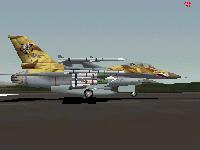
Evolution Chapter - 15...
While the actual evolution of the F-16 to this point is impressive, the potential
remains revolutionary. Electronically scanned array radar technology, as used in
the F-22, improves the aircraft's ability to detect and track more ground and air
targets. The radar also reduces radar cross section, provides several new operating
modes, and allows interleaving (simultaneous operation of more than one radar mode).
Internal sensor suites and countermeasure systems reduce drag significantly. More
and larger color displays improve upon an already exceptional interface between
pilot and plane. Interior and exterior lighting makes the F-16 fully compatible
with night-vision systems. Conformal tanks increase range and free up hardpoints
for additional weapons. Thrust vectoring enhances dogfighting abilities and
eliminates angle-of-attack restrictions. Many of these systems and capabilities
have already been demonstrated in the F-16.
A tail-less version of the F-16XL has been proposed for a flight test program. This
program, however, has not been funded. All-electric flight controls being tested
on the AFTI/F-16 for the JSF program could find their way into new production F-16s.
Research at Lockheed Martin into unmanned F-16 variants represents the more radical
end of the spectrum. These aircraft are being called uninhabited combat air vehicles
or UCAVs. As a first step in the development of UCAVs, the company is proposing to
convert an F-16 into an UCAV configuration as a demonstration platform. The airplane
would be used to prove autonomous vehicle control, to demonstrate up-link command
technologies, and to develop operational requirements. Another proposed F-16 UCAV
has a sixty-foot wingspan and 22,000 pounds of internal fuel capacity. The configuration
could maintain an unrefueled, eight-hour presence on a nominal combat air patrol
mission. A prototype could be built and flying in less than two years.
Other studies have shown that F-16s could be easily modified to become remotely
piloted drones. These aircraft would be much less expensive to maintain and operate
than USAF's current QF-4 and QF-106 drone fleet. Like these Q-planes, a QF-16 could
be piloted from the ground or from the cockpit.
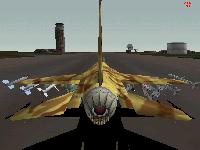
Evolution Chapter - 16...
The YF-16 flew for the first time in 1974 at Edwards. The first production F-16
rolled out of the factory in Fort Worth in August 1978. Since then, over 3,600
F-16s have rolled off assembly lines in five countries. Nineteen air forces fly
the Fighting Falcon. Several are planning follow-on buys. A dozen other countries
are considering the fighter to modernize their fleets. F-16 production is expected
for another ten years and front-line service will extend beyond the year 2020.
The long production run and the F-16's low cost have given the airplane latitude
to expand its capabilities. The F-16 has grown extensively within the external
lines of the first F-16. The limited external changes are a tribute to the
optimization of the original design and huge advancements in avionics. The
airplane continues to grow, mainly through software changes, to accommodate new
weapons and sensors.
The present state of the F-16 covers a broad range. While some F-16s perch atop
poles for public display, others test the latest weapon technology. Those rolling
out of the factory and being modified by European air forces represent the most
advanced operational fighter produced today. Even though the F-16 has been around
for over twenty years, its evolution continues to build on the fundamental strengths
of the original design.



















